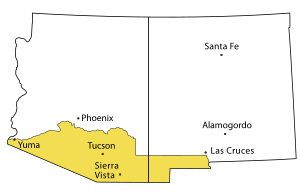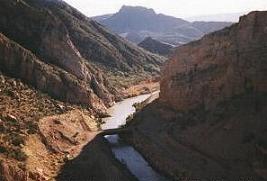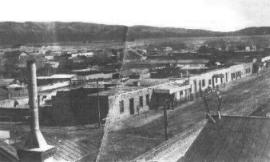Southern Arizona facts for kids
Southern Arizona is a part of the United States located in the southernmost area of the State of Arizona. People sometimes call it Gadsden or Baja Arizona. "Baja Arizona" means "Lower Arizona" in Spanish.
Contents
Exploring Southern Arizona's Geography
Southern Arizona doesn't have exact borders, but it usually includes all the land south of the Gila River. Sometimes, it just refers to Cochise County, Pima County, and Santa Cruz County. The biggest city in this area is Tucson. Other important cities and towns include Ajo, Casa Grande, Gila Bend, Oro Valley, Sierra Vista, and Yuma. There are also border cities like Nogales and Douglas.
Important Places and Natural Wonders
Southern Arizona is home to big U.S. Army and U.S. Air Force bases. These include Fort Huachuca and Davis–Monthan Air Force Base.
A major science spot here is the Kitt Peak National Observatory. It has several astronomical observatories (places to study stars) located west-southwest of Tucson.
The region also has many large national monuments. These special areas protect the beautiful scenery, amazing wildlife, and old archaeological sites. You can also find the Saguaro National Park here. This park is split into two big sections, one west of Tucson and one east of it. It's famous for its giant saguaro cacti!
Southern Arizona has several small mountain ranges. Some of these include the Chiricahua Mountains, Huachuca Mountains, Santa Ritas, Santa Catalinas, Rincons, and Piñalenos. Even though Arizona is known for its deserts, some of these mountains are tall enough to get cold and wet in winter. This means you can even go alpine skiing at ski resorts with lifts, not far from cities like Tucson!
Getting Around Southern Arizona
People usually travel long distances in Southern Arizona by highway or train.
Major Highways and Roads
One main highway is Interstate 10. It crosses Southern Arizona from the border with New Mexico through Tucson. Then, it continues northwest through Casa Grande to the big cities of Phoenix, Scottsdale, and Mesa.
Another important road is Interstate 8. It goes west from Casa Grande through Yuma and into California, crossing the Colorado River. There's also a shorter highway, Interstate 19, which runs south from Tucson to Nogales, Arizona. This is a major crossing point into Mexico.
An older highway, U.S. Route 80, used to cross Southern Arizona from east to west. Much of its western part has been replaced by Interstate 8.
Train Travel and Airports
A Transcontinental Railroad (a train line that crosses the whole country) goes through Southern Arizona, passing through Tucson and Phoenix. There's also a major train line that comes from Northern Arizona, through Phoenix, Casa Grande, and Tucson, all the way to Nogales. In Nogales, it crosses the border and connects with Mexican railroads.
The main airport for Southern Arizona is Tucson International Airport. It's located just south of Tucson.
Southern Arizona's Past
People have lived in Southern Arizona for thousands of years. The Hohokam were the main people living here before Europeans arrived. More recently, the O'odham tribe, a group of Native Americans, has lived in this area. They still live in their traditional homeland today.
Early History and Land Changes
In the early 1700s, several Spanish missions (religious settlements) were started by Father Eusebio Francisco Kino. This area was then called the Pimería Alta. After the Mexican–American War in 1846–47, the United States bought a large part of Southern Arizona from Mexico. This happened in 1854 and was called the Gadsden Purchase. The U.S. paid $15,000,000 for the land.
The Cold War Era
Southern Arizona played a big part during the Cold War. Davis–Monthan Air Force Base was home to a group of 18 huge Titan II Intercontinental Ballistic Missiles (ICBMs). These missiles were spread out in launch sites south, southwest, and southeast of Tucson.
By the mid-1980s, these missiles were getting old. Also, new agreements to reduce strategic nuclear weapons meant they were no longer needed. All but one of their launch sites were destroyed. The one remaining site, Titan II ICBM Site 571-7, is now the Titan Missile Museum. It's about 15 miles south of Tucson on Interstate 19 and is a National Historic Landmark. You can visit it to learn about this part of history!
Thinking About a New State
Since 1987, some people in Southern Arizona have thought about separating from the rest of Arizona. They wanted to form a new U.S. state, possibly called Baja Arizona or Gadsden. This idea gained more attention in February 2011. A group of lawyers, mostly from the south, felt that the Phoenix area had too much conservative control. They believed this was different from the views of Democrats in the south. The people organizing this movement hoped to have a vote on the idea in 2012 in Pima County, and possibly in Santa Cruz County and Cochise County. However, as of 2013, no official votes were planned.




